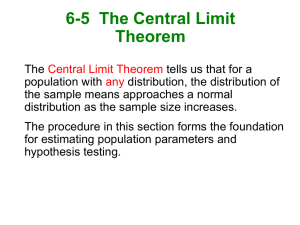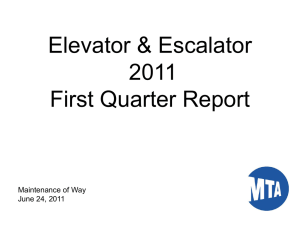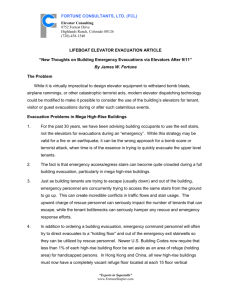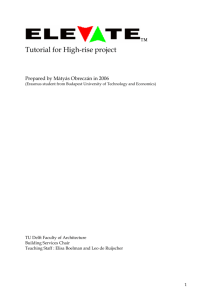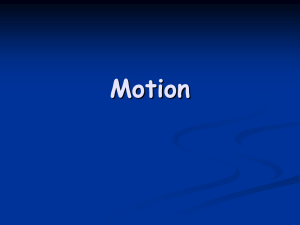The Elevator Problem - North Carolina School of Science and
advertisement
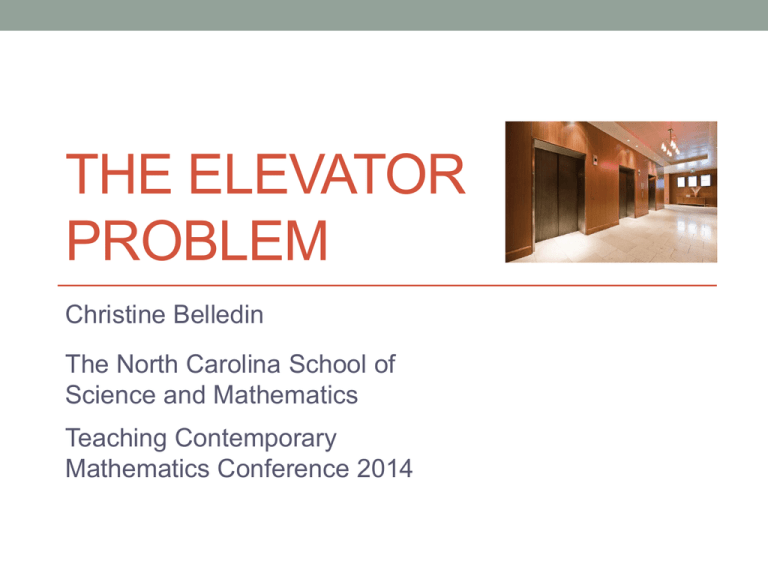
THE ELEVATOR PROBLEM Christine Belledin The North Carolina School of Science and Mathematics Teaching Contemporary Mathematics Conference 2014 What is mathematical modeling? According to the Common Core Standards for High School: Modeling is the process of choosing andusing appropriate Mathematics and statistics to analyze empirical situations, to understand them better, and to improve decisions. What did students have to say about the Elevator Problem? “Never before, in all my math experiences, had I seen a problem as open ended and varying as this one. Working on a problem like this with no obvious answer and many different options was a wholly new experience for me. This problem helped me visualize the role math could and most likely will play in my future.” The Elevator Problem In some buildings, all of the elevators can travel to all of the floors, while in others, the elevators are restricted to stopping only on certain floors. Why? What might be the advantage of having elevators that travel only between certain floors? Suppose a building has 5 floors (1-5) that are occupied. The ground floor (0) is not used for business. Each floor has 60 people working on it. There are three elevators (A, B and C) available to take these employees to their offices in the morning. Everyone arrives at approximately the same time and enters the elevators on the ground floor. Each elevator holds 10 people and takes approximately 25 seconds to fill on the ground floor. The elevators then take 5 seconds between floors and 15 seconds on each floor on which it stops. Simplifying Questions 1) Suppose it is a holiday and only 5 people come to work today. Each person works on a different floor, and they all ride the same elevator. How long will it take for everyone to get to work? 2) Now suppose that 5 people come to work and these five people do not all work on different floors. How long will it take for everyone to get to work? Why was question (2) harder to answer than question (1)? What assumptions will you need to make in order to simplify the problem? Assumptions my students made to simplify the problem • The elevator is filled to capacity (10 people) for each trip. • The elevator must stop at every floor during each trip. • No one takes the stairs. • No one uses the elevator to go down during this time (or if they do, it does not impact the time for the elevator to complete it’s trip). • The elevator doors don’t have to re-open on any floors. Updated Questions • If all elevators go to all floors, how long will it take everyone to get to work? • If 80 people were late using the unrestricted elevators, approximately what time did the employees begin arriving at the ground floor? • Reassign the elevators to transport the employees to their offices as quickly as possible. What arrangement produces the shortest time? If this arrangement had been used today, would everyone have arrived at their floor on time? What strategies did we use that we can apply to future mathematical modeling adventures? • We used a simple case to understand the structure of the • • • • • problem. We drew a diagram to help us visualize the scenario. We thought about what made the problem hard to help us figure out simplifying assumptions. We considered the worst case scenario and solved this rather than trying to think about all of the different possibilities. We found a solution that worked, then we modified it to see if we could improve it. We had to make sure our solution was realistic. (Sometimes “mathematically optimal” is not optimal in the real world.) Extensions • If a fourth elevator is added to the building, how should the elevators be organized to get employees to their offices as quickly as possible? • Consider our assumption that each elevator stops at each floor on each trip. How realistic is this? In other words, how likely is it that an elevator could skip one floor in a given trip? Two floors? • Suppose the number of workers on each floor is not equal. How does this distribution of workers change your elevator assignment? Floor 0 1 2 3 4 5 # employees 0 100 100 70 100 50 Things I’ve learned… • Think about what information you give to students and when you give them that information. • Check in often. Struggle is important, but it needs to be productive. • Communicate with students how they will be graded on this assignment. • If this is their first experience, consider grading only on effort (or not at all). • If you want to assess their ability to communicate their findings, consider giving students the chance to revise their work. • You want to encourage creativity. What grade do you assign to an incorrect answer that is based on a really good idea versus a correct answer that was very straightforward? It’s hard for us to let go of details. “I loved how realistic it was, aside from no one taking the stairs.” What else did students have to say? We see the power of collaboration. “In my pod, I felt like none of us could have solved the problem on our own but we pooled together our knowledge and we found that it was possible to solve it together.” We struggled. And we learned that we can persist through the struggle. “It was also a very complex problem, much more complex than I had ever done before. We had to set assumptions to reduce the amount of variables and make the project manageable. Even with the assumptions the problem was daunting. We had to break it down logically instead of just trying to plug it into a memorized equation. This thought process is very common in this class, and while I found it confusing and hard, I end with deeper understanding of how to do the problems.” “The elevator problem was probably the first time in the class that I felt like I was trying to comprehend something completely beyond my intelligence, but eventually I figured out what we are doing.” We liked it! “I absolutely loved the elevator problem because it was so intricate and complex. I also liked that it might actually be helpful one day and have real world application. I liked that in order to find the one of many possible final solutions, you must first solve for one tiny section, how long it takes to get to one floor, and then apply it to the whole process. I think this was also one of my favorite problems because it was a reasoning problem instead of a computation problem. I wish we would do more problems like these more often.” We can see the relevance of this problem and this process to our lives. “I don't know what a profession that focuses on efficiency (workplace or public) is called, but I would love to work out things like this for a living.” “In most of my other math classes, the concepts were mostly superficial; in the sense that we only learned the basics and processes of a certain idea without working on how it could be used in real life. Of course, this was often nice and easy, bit if I'm looking to work in a STEM field one day, it is crucial to understand the applications of the different things we learn.” Request for feedback • What kinds of resources could we provide that would help you use this kind of problem with your students? • What kind of resources would your colleagues want to see? All feedback is welcome! belledin@ncssm.edu or teague@ncssm.edu References • Common Core State Standards Initiative, Common Core State Standards: Mathematics, http://www.corestandards.org/the-standards/mathematics • Compton, Helen and Dan Teague. “The Elevator Problem.” Everybody’s Problems, Consortium, Number 57, COMAP, Inc. Lexington, Massachusetts, 1986. • Mueller, Claudia M., and Carol S. Dweck. "Praise for Intelligence Can Undermine Children's Motivation and Performance." Journal of Personality and Social Psychology 75.1 (1998): 33-52. • PISA 2012 Mathematics Framework Draft, http://www.oecd.org/pisa/pisaproducts/46961598.pd • President’s Council of Advisors on Science and Technology, PCAST, Engage to Excel: Producing One Million Additional College Graduates with Degrees in Science, Technology, Engineering, and Mathematics, Office of Science and Technology Policy, Washington DC, February 2012, http://www.whitehouse.gov/sites/default/files/microsites/ostp/pcast-engage-toexcel-final_2-25-12.pd


